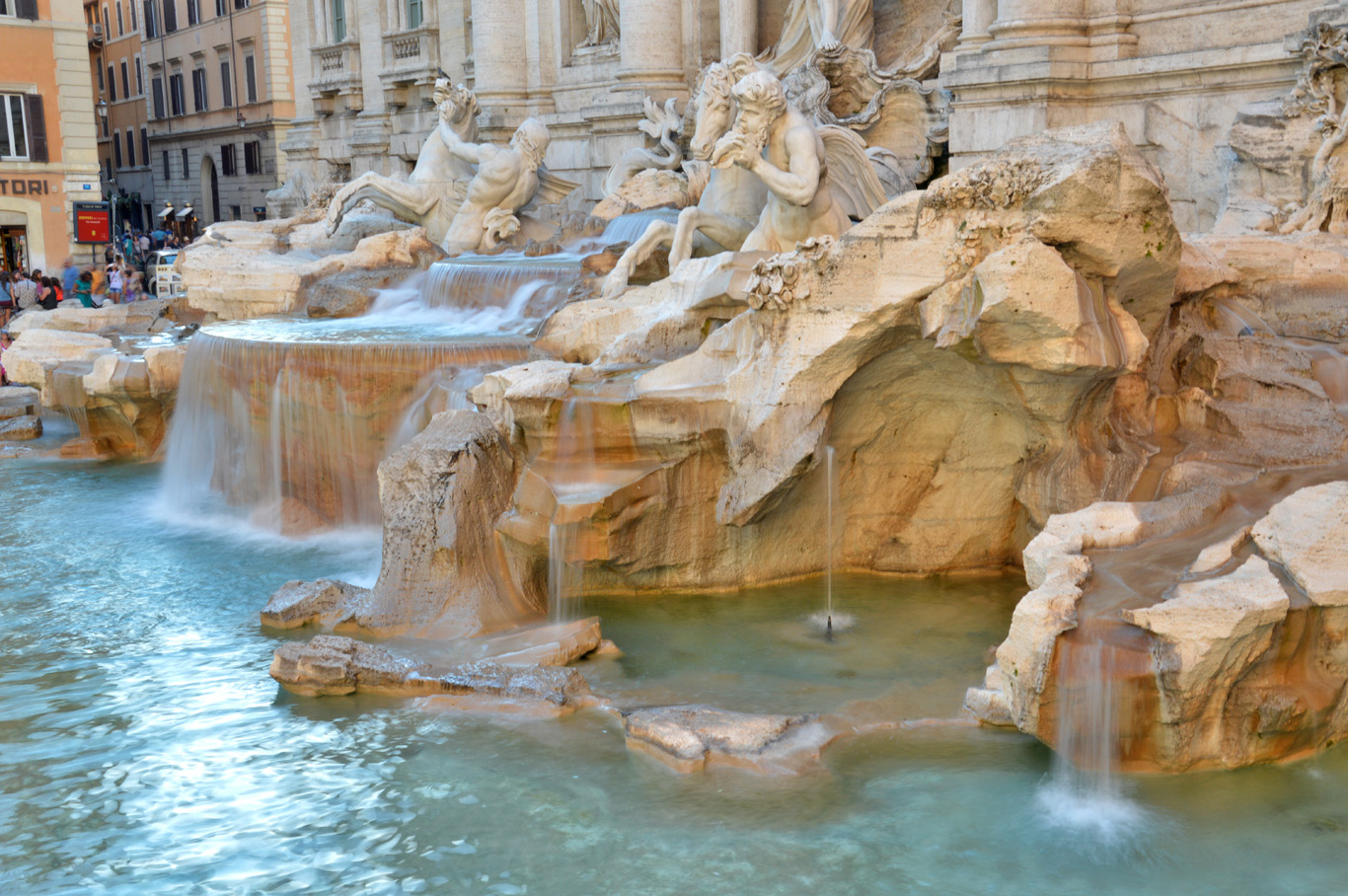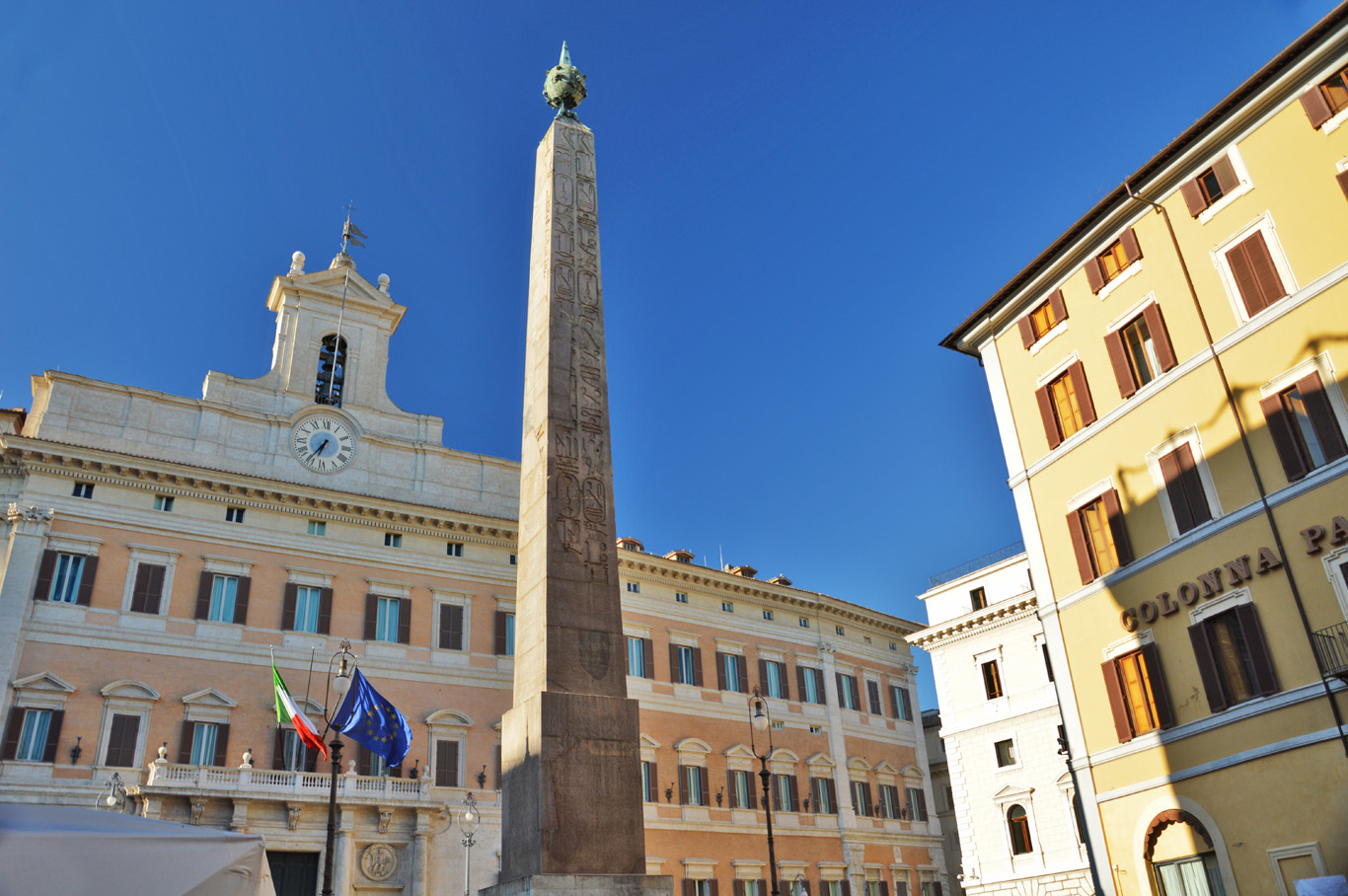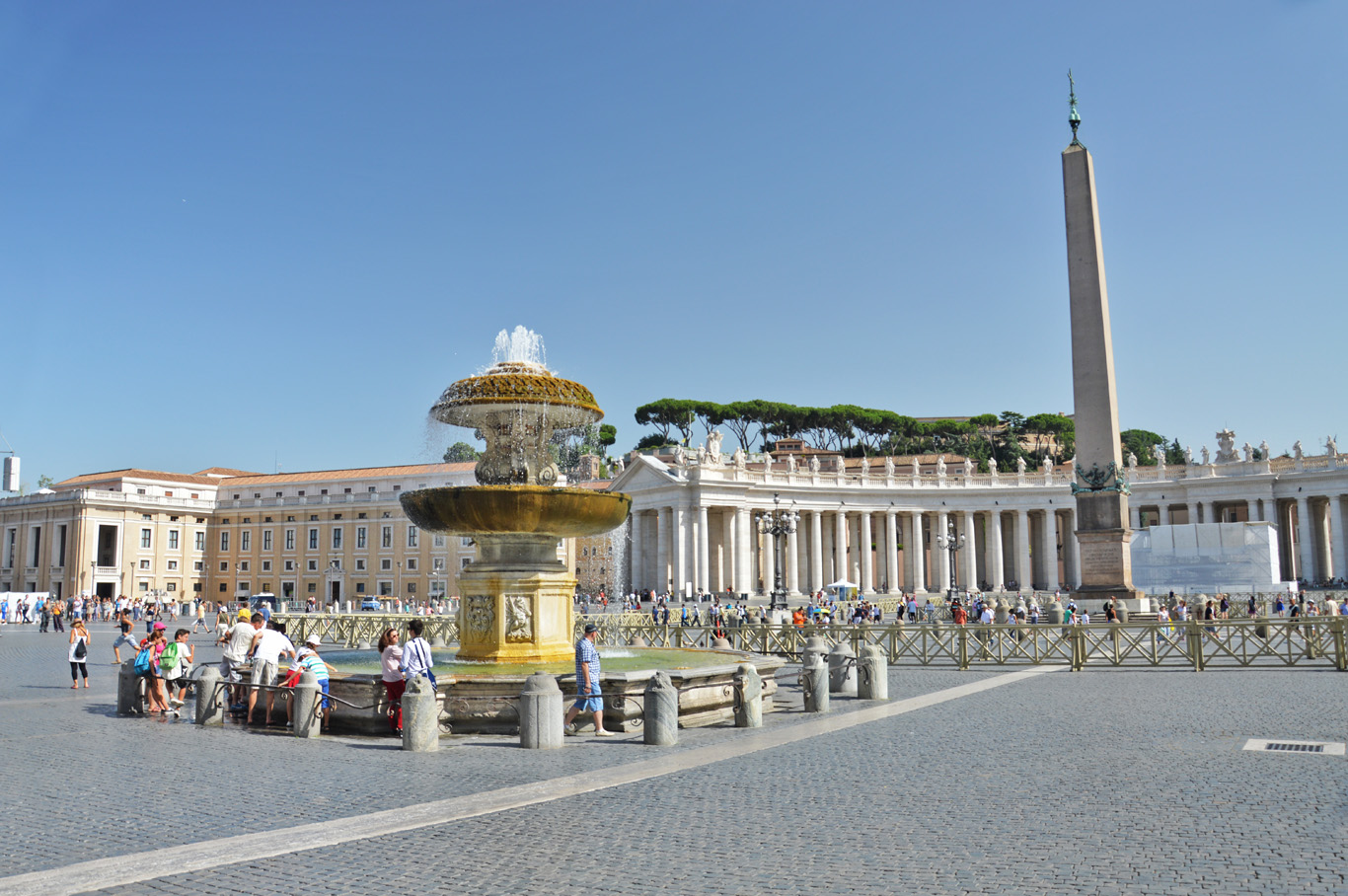I spent my first day in Rome visiting the ancient ruins and monuments within the strict center of the ancient city. On Day 2, I decided to stroll down the streets admiring more 'modern' architecture and main Renaissance and Baroque sites. I visited multiple squares and had the original thin-base Italian pizza in one of the cozy restaurants in a quiet street with not many tourists. A must when you are in Italy! But be careful while choosing a restaurant because the menu may be highly overpriced (see the tourist traps and how to avoid them at the end of this post).
Again, starting from Roma Termini Train Station, I will show you how I visited all the sites featured in this post on a budget, using only the red Metro line a few times and also my own feet (a lot!). You will have a chance to visit many beautiful places if you are not afraid of a walking :)
Back to DAY 1 - Ancient heart of Rome >>
Day 2 - Pantheon and Renaissance and Baroque Rome
Piazza di Spagna and Spanish Steps
It's very easy to get to Piazza di Spagna from Termini Train Station. Just take Metro from 'Termini' to 'Spagna' and in a couple of minutes you will reach the famous Renaissance style Spanish steps, the widest staircase in Europe. It was completed in the eighteenth century and consists of 135 steps leading up to the Trinita dei Monti church dating back to the sixteenth century. Nearby, there is also the seventeenth century fountain called Fontana della Barcaccia - "Fountain of the ugly boat". Spanish steps are visited and occupied by tonnes of tourists who sit on them and moving around might be frustrating and time consuming at times. After visiting the Spanish Steps, I took the metro train and got off one stop further, 'Flaminio'.
Spanish steps crowded by tourists, Trinita dei Monti church on top
Fontanna della Barcaccia - "the fountain of the ugly boat"
Piazza del Popolo
Tridente - three streets leading to the city
Piazza del Popolo
At the 'Flaminio' Metro Station is Piazza del Popolo - large square with one of the Rome's biggest Egyptian obelisks (Obelisk of Ramses II from Heliopolis) in its center. It was brought to the city by Augustin in 10 BC and placed in the Circus Maximus at that time. Later, it was moved to Piazza del Popolo.
Northern gate of the piazza is the ancient "Porta del Popolo" of Aurelian Walls dating back to the third century. On the opposite side of the square there is "tridente" - three main streets leading to the city.
After seeing Piazza del Popolo, I followed the street in the middle of "tridente": Via del Corso. It will take you straight up to the the Roman Forum and Colosseum. Along this road there are many sites worth visiting.
Trevi Fountain - Fontana di Trevi
Trevi fountain is both a fountain and a great monument at the same time. The sculptures depict Neptun, the god of the sea in a chariot that is pulled by sea horses. They are all guided by the mythological creatures - tritons.
Water for this fountain was taken from the first century aqueduct - Aqua Virgo. The name of the fountain "Trevi" refers to "tre via" - three roads that met nearby.
The only disadvantage of Trevi Fountain is the masses of tourists and to visit it you will have to push your way through the crowds.
Trevi fountain
Trevi fountain
Trevi fountain - details
Pantheon
Pantheon is located in Piazza della Rotonda, near Trevi Fountain, on the opposite side of Via del Corso. It's the one of the very few ancient monuments that have survived until today nearly unchanged or undamaged. The structure is still the same as it was in the second century.
Now, the Pantheon is a Roman Catholic Church (since the seventh century) dedicated to St. Mary and the Martyrs. However, the name Pantheon refers to the word: "pantheos" which means "all gods" in Ancient Greek. And this is what this temple was originally - The Temple of All Gods of Ancient Rome.
The temple in the current shape was erected by the Emperor Hadrian in 126 AD who rebuilt it after the original building had been lost in a fire.
The Pantheon is circular in shape with a huge gate that is surrounded by columns. It's dome is the largest, unreinforced dome in the world. It contains an oculus - an opening in the center which is the main source of natural light in the temple.
One interesting thing about the Pantheon would be the fact that a 43 meter (142 ft.) diameter sphere would fit perfectly between the dome and the floor of the building.
Victor Emmanuel II Monument (The Altar of the Fatherland)
Further down Via del Corso, you will find the Victor Emmanuel II Monument (Monumento Nazionale a Vittorio Emanuele II - Altare della Patria in Italian). It's one of the newest attractions in Rome. It was completed in 1925. It's made of white marble and consists of stairways, fountains, sculptures and multiple columns. The main statue of the monument is the sculpture of Victor Emmanuel (first king of united Italy).
The monument is somehow controversial because of several reasons: It occupies a considerable part of the Capitoline Hill where many medieval buildings used to stand. Unfortunately, they had to be demolished to provide space for the construction of the monument. Some people claim that it's too 'pompous' and contrasts too much with the dark brick ruins in the area. It earned a couple of funny nicknames such as 'typewriter' and 'wedding cake'.
Victor Emmanuel II Monument
Pantheon
Pantheon inside
One of many Egyptian obelisks in Rome
Victor Emmanuel II monument
St. Peter's Basilica
Visiting the Victor Emmanuel Monument, you will realize that you've made a circle and now you are just beside The Roman Forum and Colosseum again. The easiest way to get from the ancient part of Rome to the Vatican is to take the metro at "Colosseo". You need to change the line at Termini and then take another train to "Ottaviano" stop. Now you are just a stone's throw away from the Vatican City.
St. Peter's Square (Piazza San Pietro) and St. Peter's Basilica are the main attractions in Rome, besides the ancient district. You can visit the basilica and the square in an hour or so (the lines are really long and there are security checks so getting inside might take a lot of time). However if you want to see the Vatican city, the museums and St. Angel's Castle (Castel Sant'Angelo) you should have a whole free day to do it.
The construction of St. Peter's Basilica, late Renaissance style, took more than one hundred years and it was finally completed in 1626. It is one of the largest churches in the world. The interior is very impressive with huge domes and walls lavishly decorated with paintings and sculptures.
The Basilica is believed to be built on the St. Peter's burial site - his grave is situated right beside the altar.
The Egyptian obelisk in the center of the square is said to have been placed originally in the Circus of Nero and was probably the witness of St. Peter's crucifixion. According to the Bible, he was nailed to the cross head downwards because he felt unworthy to die like Jesus.
Aerial view of St. Peter's Basilica
Aerial view of the Vatican
St. Peter's Square and Basilica
St. Peter's Square
St. Peter's Basilica
St. Peter's Basilica inside
St. Peter's Basilica inide
Capitoline Hill
The Colosseum at night
The model of Rome the way it was in the ancient times
4 Tourist Traps to Avoid When on Holiday in Rome
Rome is undoubtedly one of the most beautiful and enchanting cities in the world, with its vast cultural wealth and, at the same time, thriving modernity. For this and many other reasons, tourists from across the world have been drawn to Rome for centuries. And while a city break in the eternal city often leaves visitors with many delightful memories, there are many pitfalls into which unwary tourists often fall, sometimes tainting the experience with the bitter taste of being ripped off. So how can you avoid the tourist traps while still enjoying everything this great city has to offer?
1. Keep your valuables safe
Common sense is the key here as Rome, like many cities, is a hotbed for cunning pickpockets who have mastered the art of taking advantage of flustered and distracted tourists. When traveling on the metro or walking through crowded streets, you should always keep an eye on your belongings. Try to avoid taking large sums of cash and expensive items out with you, and do not openly use pricey mobile phones or cameras if possible. Avoid Termini station late at night as it is notorious for thieves preying on unwary travelers, and ensure you are aware of your surroundings at all times.
2. Exchange your currency before traveling
Another easy way to get duped as a tourist is to exchange currency with street side moneychangers or those found in stations and airports. Commission fees can be extortionate and are often hidden within the displayed exchange rates. The best way to avoid this pitfall is to shop around for currency before you leave to ensure you get the best deal.
3. Be aware of exorbitant transport costs
Unmarked minicabs should be avoided at all costs in Rome. Like in many big cities, minicab drivers in Rome will take advantage of tourists’ unfamiliarity with the sprawling city road network in order to take you on long-winded ‘scenic’ routes. If you need a taxi, look for registered taxis wherever possible and try to negotiate the fee before you depart.
Take advantage of Rome taxi transfers by pre-booking them online to and from Rome’s airports, train stations and ports (http://www.cabs4rome.com), and navigate around the city using the user-friendly (and cheap) metro.
4. Choose restaurants wisely
Rome is awash with restaurants specializing in 'tourist menus', which should be avoided at all costs. Restaurants and bars located in close proximity to tourist hotspots are notorious for their high prices and low quality food, something made quite clear by the lack of local Italians dining there. For a genuine Italian culinary experience, venture off the beaten track or ask your hotel or Italian friends for a recommendation. You will find food of much higher quality at considerably lower prices. One street vendor near the Colosseum tried to sell a peach to me for 3 EUR (4 USD) each!
If you liked this article, you can also download it via the GPSmyCity app - you will be able to gain access to the guide, which will direct you to all the attractions described above, even if you're offline. Download it here.
BACK TO DAY 1 - ANCIENT HEART OF ROME >>
Related Posts
Copying without permission is not allowed. If you wish to use any of the site's content (photos or text) or work with us, please contact us.
We welcome questions, advice, support or criticism. However, spam comments will be removed.





























